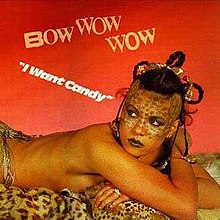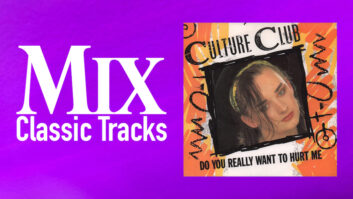One of the catchiest and most unconventional pop hits in the early 1980s was “I Want Candy,” the British band Bow Wow Wow’s spunky, percussion-heavy reinvention of the 1965 tune by The Strangeloves (a New York group that, bizarrely, claimed to be Australian). Combining a classic Bo Diddley beat with a Latin-flavored groove, the song became one of MTV’s early hits. It has remained a part of rock radio ever since and has been used in a number of films. Its enduring popularity is a testament to the vitality of the post-punk movement of the time.
After having departed Adam & The Ants following that group’s debut, Dirk Wears White Sox, guitarist Matthew Ashman, bassist Leigh Gorman and drummer Dave Barbarossa teamed up with 16-year-old singer Annabella Lwin to form Bow Wow Wow. “They wanted to do their own thing,” reports producer Kenny Laguna. “They had a sound. They gave Adam & The Ants the whole Burundi-ish thing [an African-influenced rhythmic sound], and they weren’t getting any credit for it.”

In their new group, formed by infamous Sex Pistols manager Malcolm McLaren, they fashioned a unique blend of Caribbean, African, Latin, rock and punk influences that featured grooving Burundi beats, zig-zagging bass lines, vibrant guitar and Lwin’s infectious vocal delivery. And her controversial nude appearance on an EP cover added rebellious appeal. It seemed like a recipe for success, but that would not come so easily.
Gorman, who still intermittently performs with the band when not composing music for films, recalls that a rivalry between the American and UK offices of their label, RCA, spurred the need for “I Want Candy,” as they were scoring a Top 10 UK hit with “Go Wild in the Country.” “It had a big chorus and loads of busy bass in it,” recalls Gorman. “But the American label just wouldn’t release it. ‘It’s too crazy, especially that goddamn bass!’”
Gorman recalls that he and McLaren plotted out how they could get a “radio-accessible record” for America and decided on tackling a bubblegum track. “We’d do it in our style with a big chorus,” says Gorman. “Somehow, Malcolm found producer Kenny Laguna, and Kenny worked with [record executive] Steve Leeds, and he was the one that suggested ‘I Want Candy.’” Laguna, with engineer Mark Dodson in tow, was hired to produce four tracks for the group and allowed to bring “a song to the party.”
Bow Wow Wow was enticed down to Miami to record “I Want Candy” and three other tracks in the main room at Criteria Studios, where people like the Bee Gees, Eric Clapton and Rod Stewart had recorded major albums.
“We were these London guys going down to Miami, and we hadn’t done a lot of traveling at that point,” says Gorman. “We had a house with a cook, a maid and a speedboat. It was all rock star stuff that we really hadn’t experienced before.” He says that once they arrived at the Miami airport, the group members received cassettes of the original Strangeloves version of “I Want Candy” and listened to it on their Walkmans on their way to their rehearsal room, where they went to hash it out. That’s where they met Laguna and Dodson.
Laguna recalls things differently. He says no one had a copy of the original tune on hand, and there were other cover possibilities discussed before he got there, so once a decision was made, he called “Candy” songwriter Richard Gottehrer, who had been in The Strangeloves and was a producer working on The Go-Gos’ Vacation at the time. Laguna says he asked Gottehrer if he remembered the words to the song, which he did. Later on, Laguna called him back to clarify the guitar line, and Gottherer sang it to him over the phone. “We learned the song from the songwriter over the telephone,” proclaims Laguna. “Is that a miracle? Then we got that song down and invented our own arrangement.”
“Dave and I tried to figure out how we could do a Bo Diddley beat in our style,” recollects Gorman. “So I started scratching with my fingernail, doing the beat and the bassline at the same time, then Dave played around it. I was doing the Bo Diddley thing and he was jamming on a Latin American timbale beat around that. Kenny just said, ‘Oh my God! That’s f***ing great!’”
Bow Wow Wow’s unorthodox drummer, whose kit included two timbales in place of two rack toms, got the chance to be a bit more conventional on that cover tune. “Dave had never played a snare drum before,” states engineer Dodson. “He had a tom-tom in place of a snare. Kenny asked him to play snare drum, so that was all new to him. They really respected Kenny because he was very musical. He showed them the song and the arrangement. Matthew’s guitar [a Gretsch White Falcon] sounded amazing. Leigh was a great bass player, and Annabella had a killer voice.”
The group dove into recording at Criteria’s main room within two days. The console was a Neve with a generous number of inputs. “There were probably seven mics on the drums, a mic and a direct box on the bass, and one mic on the guitar,” recalls Dodson. “I probably would’ve been using some U87s, a D-12 on the bass drum and some SM57s. That’s probably about it.” He says the SM57s would have been on the snare and the toms; the U87s on the bass, guitar, for drum overheads and for vocals.
Classic Tracks: The Pretenders’ “Don’t Get Me Wrong”
“I Want Candy” was recorded in just two or three takes, with overdubs done after. The drums basically stayed the same, and adjustments were made to the bass and guitar tracks. Lwin’s guide vocal was replaced by new singing, which was done with other members out of the room because, as Gorman recalls, she was a bit nervous.
On the flip side, Laguna turned Gorman’s bass overdub session into a rock star moment. Gorman explains that Laguna took the bassist’s entire rig — including six 8×10 Mesa Boogie cabinets and 250W amps — and set it up in the back of the studio with an array of lights and mics to make it seem like he was onstage. Then Laguna corralled Joan Jett, The Blackhearts, Dodson and anyone else he could find into the control room to cheer the bassist on. “It was such a big event, like I was onstage, so I just turned everything up to 11 and went for it. I knocked it out. That was the bass take. I don’t know if they even used that take, but they made it fun for me.”
After redoing the bass and guitar, Laguna “had a great production idea that was very subtle,” remarks Gorman. “I’d never seen anything like it before. He played piano underneath the guitar, and you can’t hear it. But when he took it away, the guitar sounded thin.” Laguna had reportedly used this technique on Jett’s anthem “I Love Rock and Roll,” which was then climbing the charts. “[Kenny] was so in sync with what Matthew played that you can’t tell,” Laguna says. “It just gives a round, bell-like aura to each note and a thickness to the guitar chords and makes Matthew sound kind of wild.”
After the Criteria sessions, Laguna and Dodson went to the Power Station in New York to mix “Candy” and three other songs with Glen Kolotkin, who had worked with Santana and on Jett’s second album, I Love Rock and Roll. “I remember that the Power Station was so amazing because they had big, natural echo rooms,” says Laguna. “Everything was very natural in that session. There were no machines — nothing. It was just recording. Taking it out of the [playback] echo and giving it the natural echo in these huge rooms, on the tom-toms and whatnot made a big difference.”
While “I Want Candy” did not quite crack the U.S. Top 40 (and the group disbanded in 1983), the combination of extensive new wave radio airplay and its MTV popularity definitely created a major buzz for the band, and it is the song most associated with the group to this day. Guitarist Ashman passed away in 1995, but the remaining members of the group have toured as Bow Wow Wow since 1997, and both “Candy” and “Aphrodisiac” (from the group’s 1983 Mike Chapman-produced follow-up album) were used effectively in Sofia Coppola’s offbeat film Marie Antoinette.







